The House of Representatives Judiciary Committee approved a bill to punt to the states the prohibition or any control of marijuana. The bill removes cannabis from the long-standing Controlled Substance Act, which “schedules” marijuana as a dangerous drug, has a high potential for abuse and has no medical benefits.
Hooray for vertical federalism that gives states control! But wait …
What about LSD, heroin and a sundry of other dangerous drugs that the federal government has seriously controlled since 1970 so that citizens are not walking around dazed and confused? Why has marijuana been given a “get out of jail free” card, and most importantly, where are the public health, behavioral health and health care professionals who claim to be advocates for evidenced-based health-promoting policies?
The proliferation of marijuana-friendly public policies and little pushback from the health care professionals is stunning, given that our country is burdened with the enduring alcohol and tobacco abuse problems, the opioid overdose carnage and the “mysterious” ills of teen vaping. A dozen states and D.C. have legalized recreational marijuana and more are seriously considering this.
The movement to grow, distribute, market and sell marijuana officially has been around for decades. But the emerging marijuana industry’s break happened with the confluence of changes in: socio-cultural norms; legislators’ attraction to the newest consumer cash cow; and vicarious exemption to use cannabis for medicinal purposes.
Adding what undoubtedly will be another public health crisis has entered society with barely a peep from the media and health officials (public, private or nonprofit). In late August, the U.S. surgeon general, to whom public health advocates normally listen, sent a health advisory warning us of the known and potential hazards of using marijuana.
The competition to see what legislator or candidate can be the most liberal and the ring of the tax cash register has brought legislators clamoring to get on board the marijuana sales gravy train. Similarly, advocates to free marijuana are giddy about beating the ostensible Puritanesque propaganda that keeps pot out of our hands. Changing sociocultural attitudes toward marijuana does not obviate the need to see credible scientific evidence that normalizing pot will not be a major public health threat.
Normalizing marijuana on the back of reasonable consideration for medical marijuana, still in its pilot stage, is a clever bait and switch. It is understandably unpopular to be against something that will help ameliorate or placate conditions or diseases that plague people, such as cancer, PTSD, Alzheimer’s and AIDS. Hence, medical marijuana use enterprises are now available in 33 states and several territories, and more states will be joining them. Few are speaking up that making the leap from these “Compassionate Care Acts” to the mercenary “Opportunity and Reinvestment” acts is disingenuous.
Those who think normalizing marijuana will support small businesses, reduce the census in our jails, decrease addiction and street sales, and help minority communities are, well … smoking something. The cannabis trade will be an elaborate enterprise, and the drug will quickly become commodified. It is being built by high-rolling investors, influential lobbyists, real estate prospectors, specialty bankers, lawyers, and — most concerning — marketing experts with creative teams who will work to get into the heads of the many new consumers.
Tax dollars collected will be easily diluted by the bureaucratic units needed to control every facet of the business. As with tobacco, alcohol and vaping products, advertising and marketing campaigns will push the limit to gain and keep loyal customers — including our youth. Police officers need to retool how to determine who is under the influence to keep our roads safe. This adds another “profiling charge” opportunity for lawyers when police need to stop, search and seize users driving on roads.
Workplaces will need to add a tome of policies and procedures and more drug testing to ensure that employees are not toking on the job. The increasing list of maladies approved for medical use increases the pool of acceptable use.
To capitalize on “what is good about using cannabis” and to appease the push to be progressive, we should establish state laws that the growing, distribution, advertising and sale of medical marijuana be handled by health care nonprofits such as university research hospitals, hospital systems, or substance abuse and behavior health rehabilitation nonprofits. There should be none to minimal taxes, which will keep the price down for those who use it for legitimate health care reasons. It should be illegal outside of medicinal use.
This approach is truly compassionate and not opportunistic. Otherwise get ready for more substance abuse, crime and compromised health rehabilitation services that will need to be built well beyond cottage industries to keep up with the health damage by normalizing marijuana in our society.

